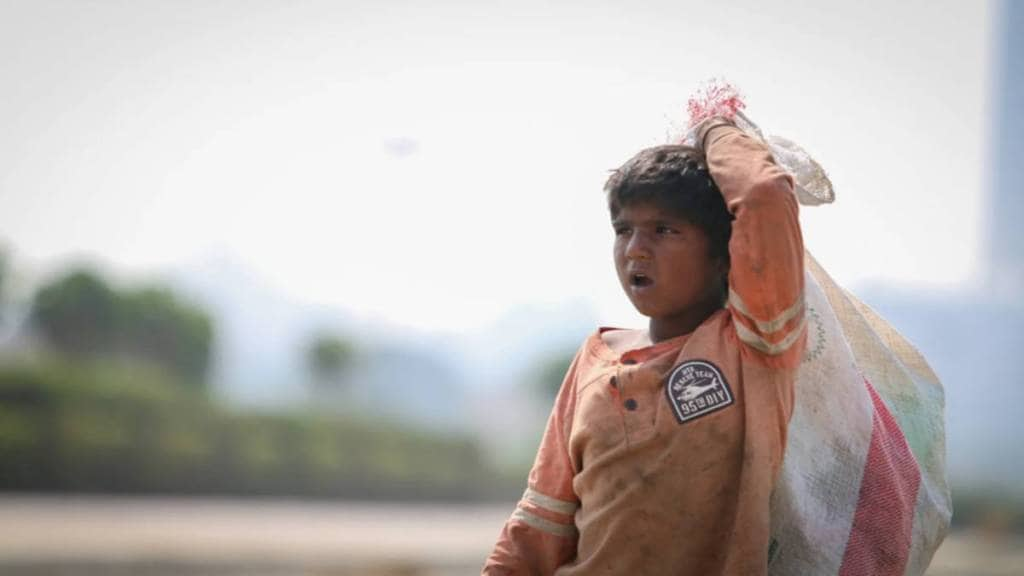By Sreya Deb
“I was carrying bricks and laying cement for twelve hours a day when I was 13 years old,” recalled 16-year-old Ravi (name changed), who survived trafficking from a village in Prayagraj to Mumbai for road construction work. “We were expected to work from 7 am to 7 pm; the employers did not provide any food. We got only a 15-minute break all day,” he recounted the horror to FE. Ravi was rescued and brought back home last year, after three years of bonded labour and abuse. However, there are lakhs of other children not so lucky.
The United Nation’s sustainable development goal 8, target 8.7, reads eradication of all forms of child labour by 2025. However, as the world marks World Day Against Child Labour on June 12, India is nowhere close to the goal, with some states even extending the deadline by a year or two. As per Indian law, children under 14 years of age are prohibited from working in any occupation, while those between 14 and 18 are forbidden from hazardous occupations as per a 2012 amendment.
Some like 15-year-old Arpita have no choice but to work. With an absent father, she had to support her family, first as a tea garden worker in West Bengal, then as a househelp, among others. “The work as a tea leaf picker was seasonal and irregular, which is why I took up the job as a maid servant,” she told FE.
Census data from 2011 states that 11.8 million children in India aged 5-17 years were employed. Analysis of the 2018–19 Periodic Labour Force Survey (PLFS 2018/19) reveals that 2% of all children -– close to 5 million children aged 5–17 -– were engaged in economic activity in India. “Globally, there are around 160 million children involved in child labour -– which is equal to that many empty seats in a classroom,” said Kailash Satyarthi, Nobel Prize winner and child labour campaigner. “While the supply side has improved with the issue of child labour having a proper legal framework in the country, the demand side has gotten worse since children are usually not paid, or paid very little, and are therefore easier hired. These empty chairs in classrooms also reflect that there are just as many adults trying to get the jobs being occupied by children” he said.
As per the latest National Crime Records Bureau (NCRB) report, Crime in India 2022, there were 751 instances of child labour across the country, impacting approximately 1,169 victims. The states with the highest number of cases were Telangana, Bihar, Maharashtra and Assam, with 257, 146, 149 and 98 victims, respectively. However, these numbers prove unreliable as compared to other sources. A 2022 report by National Commission for Protection of Child Rights (NCPCR) revealed that the number of FIRs reporting child labour mentioned by the NCRB is 476 for the entire country, whereas the annual report of the NCPCR reflected almost double that number from single states. For example, the NCPCR found that Rajasthan alone had recorded 726 FIRs in the same period.
“It is a collective responsibility of civil society, government machinery, community and parents to ensure that children take advantage of education infrastructures and facilities,” said Sushant Kumar Bhuyan, programme director at Smile Foundation, an organisation working to protect the right of education of disadvantaged children. “There is a clear mismatch between demand and supply as government-supported facilities for children are underutilised. We should help families leverage existing schemes and avenues for livelihood so that parents prioritise sending their children to school and not push them into work,” he added.
Worldwide, there has been an outcry too against brands engaging in child labour. Several companies, including Adidas, H&M and The Gap, have been exposed with having unethical practices when it comes to child labour. In an investigative piece, web publication Disclose accused Decathlon of employing child labour and engaging in trafficking as well. In the annual sustainable and social impact report of 2023 compiled by Shein, the company found several instances of child labour in its supply blockchain. Boohoo, Nike and Macy’s were also under fire for sourcing cotton from fields in Uzbekistan that employ child labour.
A report by Vogue business, later made into a documentary by BBC, revealed cases where jasmine farms in Egypt providing extract for companies like Estee Lauder and L’Oreal were employing child labour. Major brands like McDonald’s have also pledged to rework their policies to protect children, as many aged around thirteen were reported to have been working in night shifts at factories surrounded by dangerous equipment.
As per the International Labour Organisation, child labour is highest in Africa with 72 million children, while Asia-Pacific has 62 million engaged in child labour. The Africa and the Asia and the Pacific regions together account for almost nine out of every ten children in child labour worldwide. While the number of children in child labour in Asia-Pacific declined from 62.1 million in 2016 to 48.7 million at the start of 2020, unless the region achieves an average rate of reduction of 35% per annum, it is likely to have 33.4 million children in child labour in 2025 and 22.7 million children in child labour in 2030.


